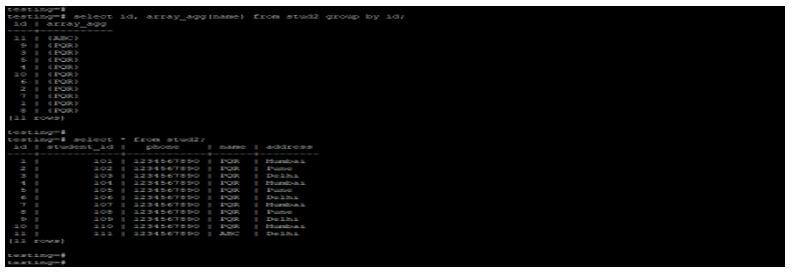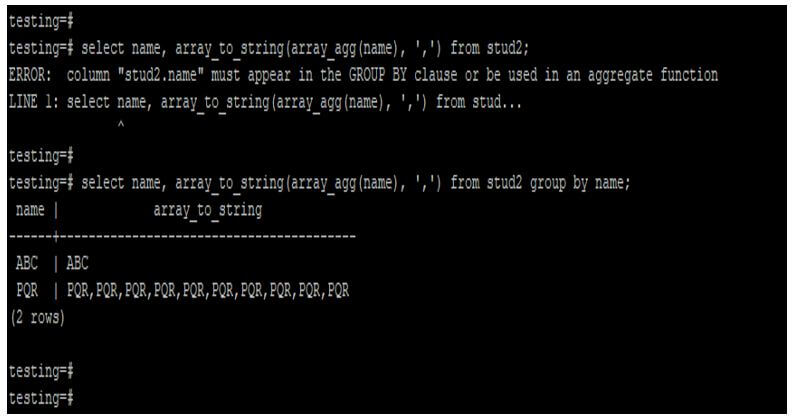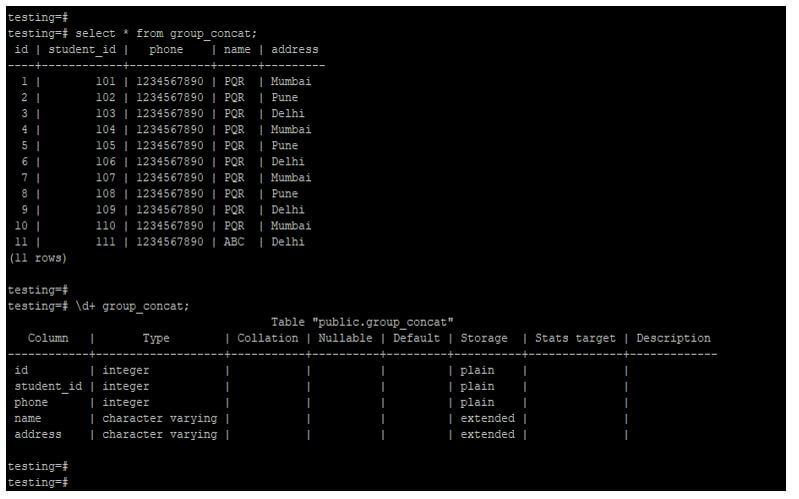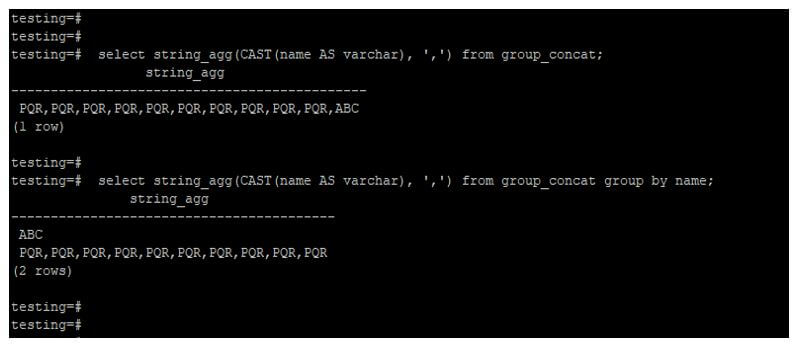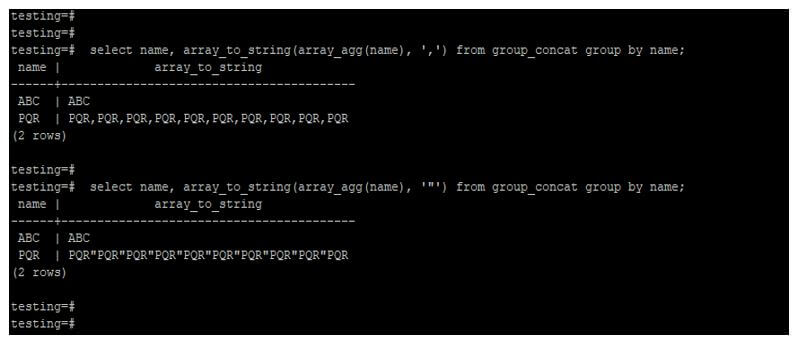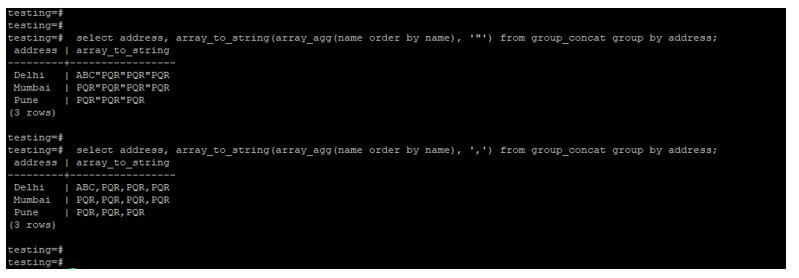Updated May 29, 2023
Introduction to PostgreSQL group_concat
PostgreSQL group_concat function is unavailable, but we have used the same function as array_agg and array_to_string to work the same as the group_concat function in PostgreSQL. There is no function available in PostgreSQL of group_concat, but we have used array_agg and array_to_string to work the same as group_concat, which function is available in MySQL. The Array_agg function in PostgreSQL will return the elements of a group of arrays, and the array_to_string function will concatenate all the array values using the separator used in the query.
Syntax of PostgreSQL group_concat
Below is the syntax :
Select name_of_column1, name_of_column2, name_of_column3, ….., name_of_columnN array_to_string (array_agg (name_of_column), “Value separator”) from name_of_table JOIN condition Group by condition;Below is the parameter description:
- Select: This operation selects the column value to concatenate using the array_to_string and array_agg functions in PostgreSQL. We can select single as well as multiple columns with the array_agg function.
- Name of column: Selecting the column name from the table allows us to retrieve and concatenate that column’s data. We achieve this by utilizing the array_to_string and array_agg functions in PostgreSQL.
- Array_to_string: The array_to_string function in PostgreSQL functions similarly to the group_concat function used in other databases. We can use this function by using the array_agg function in PostgreSQL. Both the function together same work as the group_concat function.
- Array_agg: This function in PostgreSQL works the same as the group_concat function, which was used in other database. This function is basically used to return the element from a group of arrays. This function is very important in PostgreSQL to concatenate the column values.
- Value separator: This is defined as a separate column value by using the separator, basically, we can use ‘,’, ‘;’, etc. to separate the column values by using the array_to_string and array_agg functions in PostgreSQL.
- Name of table: This is defined as selecting the table name from which we have retrieved column values and concatenating the column data using the array_to_string and array_agg functions in PostgreSQL.
- Join condition: This is defined as using the join condition to concatenate two specific table column data in PostgreSQL. We have used join operations with array_to_string and array_agg functions in PostgreSQL.
- Group by condition: This condition uses array_to_string and array_agg functions in PostgreSQL.
How group_concat Function works in PostgreSQL?
- The group_concat function is unavailable in PostgreSQL, which was available in MySQL. Instead of using group_concat in PostgreSQL, we use array_to_string and array_agg functions.
- Array_agg function is used to retrieve the array element from the table. Using this function, we are retrieving the column array elements value.
The below example shows that after using the array_agg function, we can only retrieve the array elements from the column.
Code:
select id, array_agg(name) from stud2 group by id;
select * from stud2;Output:
- Above figure shows that we are using the array_agg function on the name column after using this function on the name column, it will only display all values from the column in array element format.
- We primarily use the array_to_string function to combine values from a table column. We retrieve these values from the array elements by employing the array_agg function in PostgreSQL.
- Using the Array_to_string function and array_agg function, we have combined the column rows using a separator.
- Value separator is very useful and important while using Array_to_string and array_agg functions in PostgreSQL.
- We have also used the string_agg function to concatenate column values in PostgreSQL. The String_agg function is very useful and important while concatenating column values in PostgreSQL.
- We need to use group by clause with array_to_string function and array_agg function in PostgreSQL, if we have not used group by clause, it will issue an error.
Below example shows that we need to use group by clause with an Array_to_string function and array_agg function in PostgreSQL.
Code:
select name, array_to_string(array_agg(name), ',') from stud2;
select name, array_to_string(array_agg(name), ',') from stud2 group by name;Output:
- In the above example, if we have not used group by clause, it will issue an error. After using group by will not issue an error, it will display concatenated output of column values.
Examples of PostgreSQL group_concat
We use the group_concat table to describe an example of the group_concat function in PostgreSQL.
Below is the data and table description of the group_concat table.
Code:
select * from group_concat;
\d+ group_concat;Output:
Example #1
Group concat using the string_agg function.
- Below example shows that concatenate table column by using the string_agg function.
- We are concatenating the name column from the group_concat table.
Code:
select string_agg(CAST(name AS varchar), ',') from group_concat;
select string_agg(CAST(name AS varchar), ',') from group_concat group by name;Output:
Example #2
Group concat using array_agg and array_to_string function.
- Below example shows that concat table column by using array_agg and array_to_string function in PostgreSQL.
- We have concatenated the name column from the group_concat table.
Code:
select name, array_to_string(array_agg(name), ',') from group_concat group by name;
select name, array_to_string(array_agg(name), '”') from group_concat group by name;Output:
Example #3
Group concat to order each column using array_agg and array_to_string function.
- Below example shows that group concat to order each column using array_agg and array_to_string function in PostgreSQL.
- We have used the name and address column from the group_concat table.
Code:
select address, array_to_string(array_agg(name order by name), '"') from group_concat group by address;
select address, array_to_string(array_agg(name order by name), ',') from group_concat group by address;Output:
Conclusion
There is no function like group_concat available in PostgreSQL, which was available in MySQL; instead of using this function, we are using array_agg and array_to_string function. The Array_agg and array_to_string functions will work the same as the group_concat function in other databases. We can also use the string_agg function in PostgreSQL.
Recommended Articles
We hope that this EDUCBA information on “PostgreSQL group_concat” was beneficial to you. You can view EDUCBA’s recommended articles for more information.


